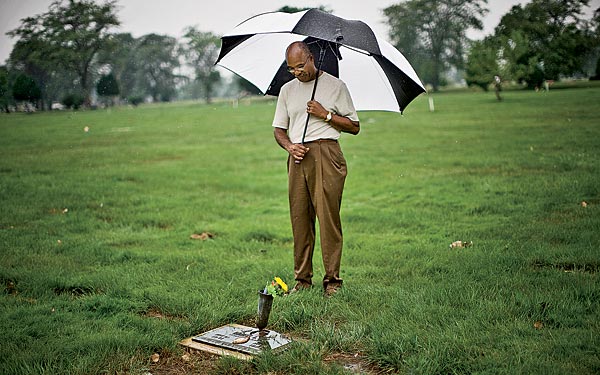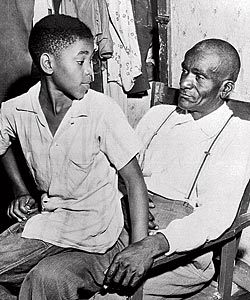
Simeon Wright visits his cousin Emmett Till’s grave at Burr Oak Cemetery.
It’s achingly difficult to dig up what you have spent a lifetime trying to push down. In recent years, Simeon Wright has moved slowly, steadily, inching his way toward revelation. He has faced what he wanted to put behind him, recalling the events surrounding the 1955 lynching of his 14-year-old cousin, Emmett Till.
As painful as it might be to relive a night of terror in his house on Dark Fear Road in Money, Mississippi, Wright endured an additional source of discomfort. With all the coverage and dramatic treatment of the Emmett Till story over nearly 55 years, too many people still were getting it wrong.
With his book, Simeon’s Story: An Eyewitness Account of the Kidnapping of Emmett Till, written with the journalist Herb Boyd and published in January by Lawrence Hill Books, Wright intends to expose the errors of past renderings of the story and, in the process, gain some measure of justice. “I’m excited in a way that I get a chance to tell what actually happened,” says Wright, 67, a retired pipe fitter who lives in west suburban Summit Argo.
What happened in 1955 not only became a cautionary tale for a generation of young African Americans learning about race relations but also lit a spark for the modern mass civil rights movement. The essentials of the story are familiar: The Chicagoan Emmett Till and his cousin Wheeler Parker Jr. were visiting the Wright family in August 1955. The boys, along with a group of friends and cousins, were in Bryant’s Grocery and Meat Market in Money when Emmett whistled at Carolyn Bryant, who was white and who owned the store with her husband, Roy Bryant.
“I think [Emmett] wanted to get a laugh out of us or something,” Wright says. “He was always joking around, and it was hard to tell when he was serious.”
This was no joking matter. The Mississippi Delta region was at the epicenter of an eruption, where “the Ku Klux Klan and night riders were part of our daily lives,” Wright recalls in the book. All this was on Wright’s mind when he heard that whistle.
“Well, it scared us half to death,” he recalls in an interview. “You know, we were almost in shock. We couldn’t get out of there fast enough, because we had never heard of anything like that before. A black boy whistling at a white woman? In Mississippi? No.”

Wright sits on his father Moses’s lap in 1955.
Still, everyone kept the promise not to tell Wright’s father, Emmett’s great-uncle, Moses Wright, whom Wright insists would have hustled Emmett out of town. When nothing was said or done over the next couple of days, the boys forgot about the incident.
But at 2 a.m. on August 28, Roy Bryant showed up at the Wright home with his half-brother, J. W. Milam. The two white men terrorized the Wright family and took Emmett from the bed he shared with Wright. Outside, a female voice could be heard saying Emmett was “the one.” Emmett was taken away, beaten, shot, and dumped in the Tallahatchie River, a 75-pound gin fan tied to his neck with barbed wire.
Although Bryant and Milam stood trial for murder, and Moses Wright courageously identified them in open court, they were acquitted by an all-white jury, only to later confess in Look magazine. The Wright family left Mississippi—forever—and relocated to suburban Chicago in search of a new life.
“I couldn’t shake the many thoughts of him,” Simeon Wright recalls in his book. All the questions that inevitably haunt the survivor: “What if we had stayed home that night? What if we had told Dad?”
Despite help from understanding teachers, Wright wound up looking for trouble—trying to express the pain that words could not describe. “Mostly every Saturday night, we would wait for the white boys to call us the N-word,” he recalls in an interview.
“And we would get into fights.” Clearly, this was not the right path. “Sooner or later, you can only have so many fights before someone pulls a gun.”
At 24, Wright says he “committed my life to Christ” and found peace, along with forgiveness for Bryant and Milam. “You are compelled to do that,” says Wright, now a deacon in the Argo Temple Church of God in Christ, the church pastored by Till’s cousin, the Reverend Wheeler Parker Jr., and founded by Till’s maternal grandmother, Alma Carthan. “You have to learn how to forgive those who have wronged you.”
Even so, Wright says he remained troubled by what he insists is the persistent misreporting of Emmett’s story. His book includes an appendix titled “Lies, Myths, and Distortions,” in which he seeks to clarify several points with his eyewitness account and the results of an autopsy of Emmett’s remains. Among Wright’s clarifications: Despite testimony to the contrary, Emmett’s wallet did not contain a photo of a white girl; no one dared Emmett to flirt with Carolyn Bryant, and he never spoke out of turn to her (as she later claimed at trial); Emmett was not castrated; he was not tortured with a drill bit.
Wright also denies one recent speculative assertion that Emmett was killed by a black man and not by his confessed killer J. W. Milam.
Even with the passage of time, Wright says he can’t entirely escape the memories. “Certain sounds bring it back. Certain smells. Honeysuckle smell. Because honeysuckle was blooming that summer.” Telling the story, setting it straight, already is making a difference, Wright believes—in his spirit, if not in court. “Hopefully, this book will be around as a record of what took place in Mississippi in 1955,” he says. Perhaps, at least, there is some measure of justice in that.
Photography: (from top) Chicago Tribune photo by Zbigniew Bzdak, (bottom) Associated Press




Comments are closed.